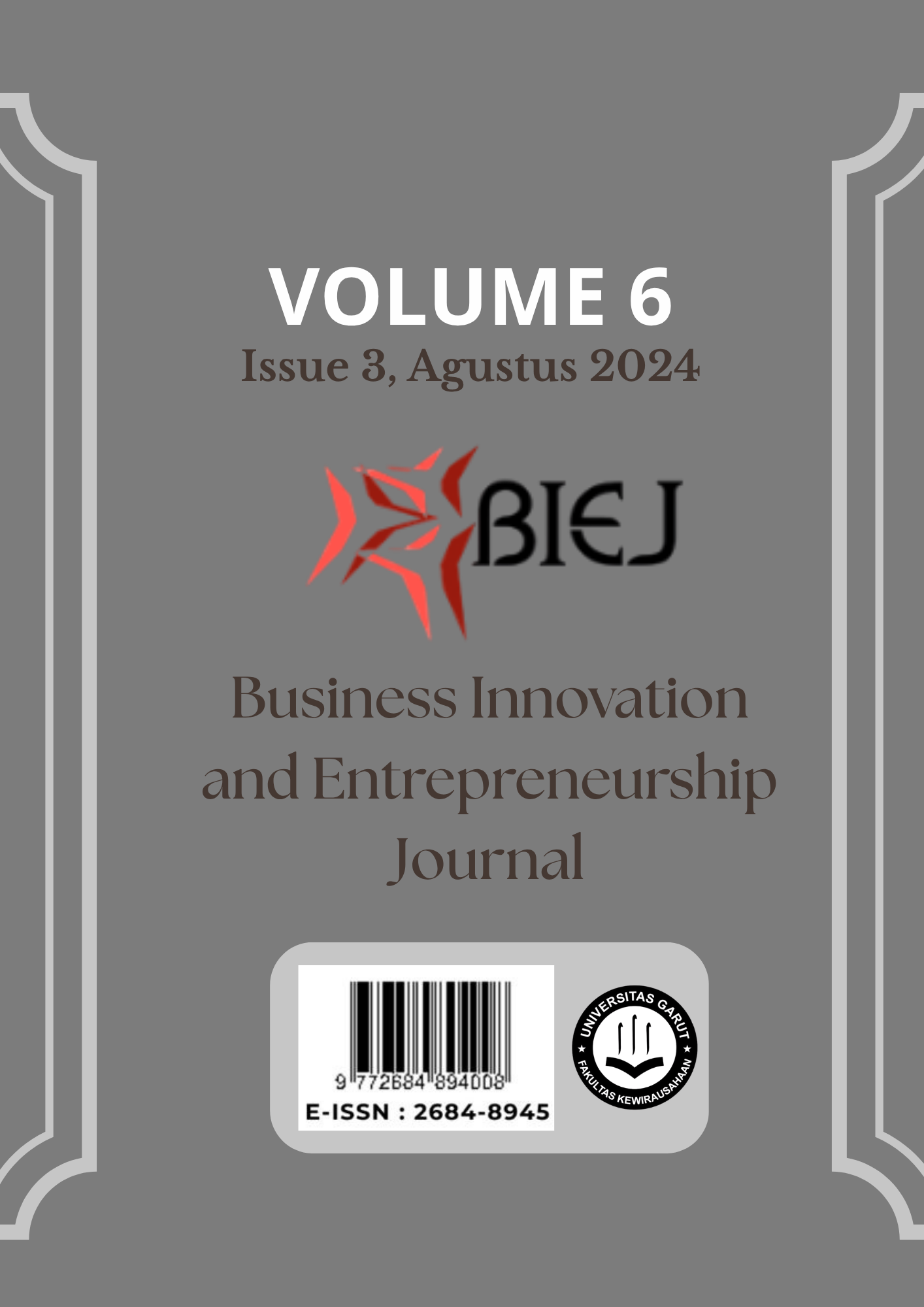Strategies for Strengthening Business Agility through Business Ecosystems in Culinary MSMEs in Regency
Abstract
This study is intended to test and analyze the effect of business ecosystem on business agility (survey on culinary micro, small and medium enterprises in Garut Regency). Micro, small and medium enterprises have a very fast role in increasing economic growth. Findings reveal that operations, research and development, transformation, and strategy are important dimensions in business agility. The purpose of this study was to determine the effect of business ecosystem on business agility in small and medium culinary businesses in Garut Regency. The population in this study were culinary micro, small and medium enterprises in Garut Regency. This type of research is explanatory survey research using a quantitative approach. The sample used in this study was 399 respondents, then processed using SPSS statistic 26 using purposive sampling technique. The analytical tools used in this research are simple linear regression, instrument test, classical assumption test, and hypothesis testing. The results of this study state that the business ecosystem variable has an influence of 62.8% on business agility. The conclusion from the results of this study is that the ability in business agility is very necessary and cannot be separated from bringing together harmony between ecosystem components in a company.
Downloads
References
P. K. Senyo, K. Liu, and J. Effah, “Digital business ecosystem: Literature review and a framework for future research,” Int. J. Inf. Manage., 2019.
G. Abdul et al., “Information Technology Resources and Innovation Performance in Higher Education,” vol. 15, no. 04, pp. 117–125, 2021.
J. Barney, “Firm resources and sustained competitive advantage,” J. Manage., vol. 17, no. 1, pp. 99–120, 1991, [Online]. Available: https://doi.org/10.1177/014920639101700108
M. Yang, N. Jaafar, S. K. Yeng, and A. Al Mamun, “Modelling the Significance of Global Mind-Set and Halal Brand Trust To Determine the Performance of Halal Smes,” 2022, publisher.unimas.my. doi: 10.33736/IJBS.4854.2022.
Y. L. Doz and M. Kosonen, “Embedding strategic agility: A leadership agenda for accelerating business model renewal,” Long Range Plann., vol. 43, no. 2–3, pp. 370–382, 2010, doi: 10.1016/j.lrp.2009.07.006.
F. Li, “The digital transformation of business models in the creative industries: A holistic framework and emerging trends,” Technovation, vol. 92–93, p. 102012, 2020, doi: 10.1016/j.technovation.2017.12.004.
G. Reischauer and D. Seidl, “Platform ecosystems as meta-organizations: Implications for platform strategies,” Strateg. Organ., vol. 18, no. 2, pp. 129–150, 2020, doi: 10.1177/1476127019884639.
S. Nambisan, S. A. Zahra, and Y. Luo, “Global platforms and ecosystems: Implications for international business theories,” J. Int. Bus. Stud., vol. 50, pp. 1464–1486, 2019, doi: 10.1057/s41267-019-00262-4.
N. A. Hamdani, R. Muladi, G. Abdul, and F. Maulani, “Digital Marketing Impact on Consumer Decision-Making Process,” vol. 220, no. Gcbme 2021, pp. 153–158, 2022.
K. Rong, Y. Lin, B. Li, T. Burström, L. Butel, and J. Yu, “Business ecosystem research agenda: More dynamic, more embedded, and more internationalized,” 2018, Springer. doi: 10.1057/s41291-018-0038-6.
T. Clauss, M. Abebe, C. Tangpong, and ..., “Strategic agility, business model innovation, and firm performance: an empirical investigation,” IEEE Trans. …, 2019.
“Office of Cooperatives and Small Businesses,” 2021.
B. P. S. K. Garut, “Statistik UMKM Kabupaten Garut 2022,” BPS Kabupaten Garut, Garut, 2022. [Online]. Available: https://garutkab.bps.go.id
B. Setiawan, A Critical Review of the Business Agility Literature in the Advancement of Information and Communication Technology. osf.io, 2018.
D. J. Teece, “Business ecosystem,” 2016, Springer.
H. Bouwman, J. Heikkilä, M. Heikkilä, C. Leopold, and ..., “Achieving agility using business model stress testing,” 2018, Springer. doi: 10.1007/s12525-016-0243-0.
R. Heisterberg and A. Verma, Creating business agility. Wiley Online Library, 2014. doi: 10.1002/9781118918241.
R. Andriani, N. A. Hamdani, and R. Setiawan, “THE EFFECT OF ENTREPRENEURSHIP KNOWLEDGE ON SELF EFFICACY AND ITS IMPACT ON STUDENTS ’ INTERESTS,” vol. 2, no. 2, pp. 126–130, 2020.
J. Ramezani and L. M. Camarinha-Matos, “A collaborative approach to resilient and antifragile business ecosystems,” Procedia Comput. Sci., 2019.
P. Grefen, O. Turetken, K. Traganos, and ..., “Creating agility in traffic management by collaborative service-dominant business engineering,” Risks Resil. …, 2015, doi: 10.1007/978-3-319-24141-8_9.
Y. Nugraha, G. Abdul Fatah Maulani, A. Didah Amalia, and A. Sandi Mutia, “BIEJ) is published under licensed of a CC BY-SA Creative Commons Attribution-ShareAlike 4.0 International License,” Bus. Innov. Entrep. J., vol. 5, no. 4, pp. 2684–8945, 2023.
S. Denning, “Strategic agility: Using agile teams to explore opportunities for market-creating innovation,” Strateg. &leadersh., 2017, doi: 10.1108/sl-04-2017-0032.
L. W. W. Mihardjo, “Customer experience and organizational agility driven business model innovation to shape sustainable development,” Polish Journal of …, 2019 - bibliotekanauki.pl.
I. B. Hani, S. Deniz, and S. Carlsson, “Enabling organizational agility through self-service business intelligence: the case of a digital marketplace,” 2017, core.ac.uk.
P. Grefen and O. Türetken, “Achieving business process agility through service engineering in extended business networks,” 2018, research.tue.nl.
P. P. Tallon, M. Queiroz, T. Coltman, and R. Sharma, “Information technology and the search for organizational agility: A systematic review with future research possibilities,” J. Strateg. Inf. Syst., vol. 28, no. 2, pp. 218–237, 2019, doi: 10.1016/j.jsis.2018.12.002.
A. Faber, A. Hernandez-Mendez, S. V Rehm, and F. Matthes, “An Agile Framework for Modeling Smart City Business Ecosystems.,” 2018, scitepress.org.
S. W. Ambler and M. Lines, An executive’s guide to disciplined Agile: winning the race to business agility (volume 1). dl.acm.org, 2017. doi: 10.5555/3164836.
C. Juneja, H. Kothari, and R. S. Rai, “Business agility: A systematic review of literature and design oriented research synthesis,” 2018, academia.edu.
M. F. Fawaz, G. Abdul, F. Maulani, and N. A. Hamdani, “Optimizing the Search for Grass Supply for Domba Garut Farmers Through Location-Based Mobile Application,” vol. 5, no. 4, pp. 291–299, 2023.
B. Srinivasan and C. Patary, “Increasing Business Agility through Organizational Restructuring and Transformation,” 2017, pmworldlibrary.net.
M. G. Jacobides, C. Cennamo, and A. Gawer, “Towards a theory of ecosystems,” Strateg. Manag. J., vol. 39, no. 8, pp. 2255–2276, 2018, doi: 10.1002/smj.2904.
R. Adner, “Ecosystem as structure: An actionable construct for strategy,” J. Manage., vol. 43, no. 1, pp. 39–58, 2017, doi: 10.1177/0149206316678451.
J. W. Creswell, Research Design: Qualitative, Quantitative, and Mixed Methods Approaches, 4th ed. Thousand Oaks, CA: SAGE Publications, 2014. [Online]. Available: https://us.sagepub.com/en-us/nam/research-design/book246121
W. L. Neuman, Social Research Methods: Qualitative and Quantitative Approaches, 7th ed. Harlow: Pearson Education Limited, 2014. [Online]. Available: https://www.pearson.com/store/p/social-research-methods-qualitative-and-quantitative-approaches/P100000874807
“researcher,” 2023.
D. Handoyo, “The Effect of Corporate Image, Location, Price and Service Quality on Customer Satisfaction of J&T Express Delivery Services,” J. Mark. Bus. Res., vol. 1, no. 1, pp. 25–38, 2021.



























